Widescreen Weekend Mission Report 2011 |
Read more at in70mm.com The 70mm Newsletter |
| Written & photographed (unless otherwise noted) by : Thomas Hauerslev, the Pope of Panorama, assisted by Paul Rayton (Hollywood, USA) | Date: 06.04.2011 |
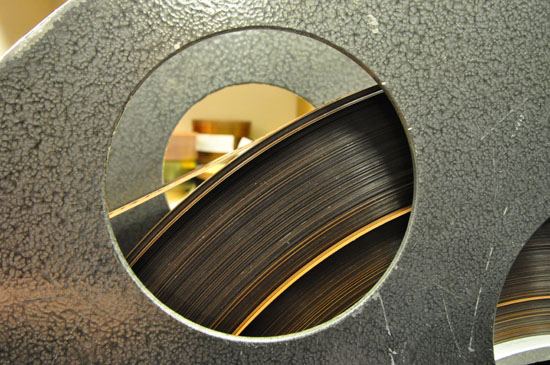 A
reel of 70mm
film, signature of the Widescreen Weekend A
reel of 70mm
film, signature of the Widescreen WeekendAfter a one year absence in Bradford I was delighted to be back for the 2011 version of the Widescreen Weekend at the Pictureville Cinema. I was happy to see old friends again and not least to meet once again the audience, some of whom I have known since my first weekend back in 1996. As Bill Lawrence has often said, it is his movie family, which we have come to know over the past 15 years. Friendships which have grown into a network of 70mm film fans across Europe and the United States. |
More in 70mm reading: Widescreen Weekend 2011 • Gallery: 2011 • Mission Report • WSW Home • Through the Years • The Best of WSW • Academy of the WSW • Creating the WSW • Planning the WSW • Projecting the WSW • Home of CINERAMA • Projecting CINERAMA "It's Bloody Marvellous" Widescreen Weekend 2011 Film introductions Internet link: French Report |
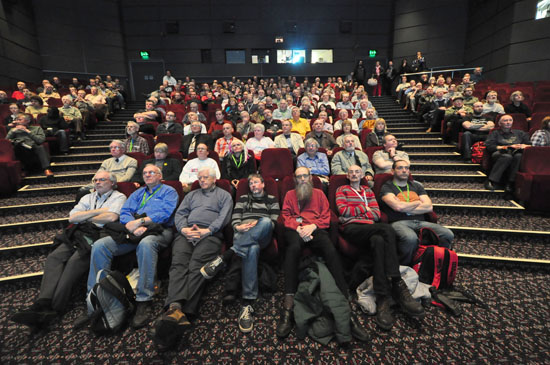 Pictureville's
fantastic and loyal audience of the Widescreen Weekend - simply the
Widescreeners Pictureville's
fantastic and loyal audience of the Widescreen Weekend - simply the
WidescreenersFor those of you Widescreen Weekend Virgins out there, unfamiliar with this 70mm festival, it is an annual film festival in Bradford, UK, which celebrates everything that is big and wide in the cinema, specifically 70mm and Cinerama. The 4-day festival attracts a large UK audience, but certainly also a lot of international guests - many of whom are festival veterans for the full 16 years. This year I heard a new definition, from one of the Swedish guests, which I thought was rather nice: It's is a festival for security addicts, you watch the same films, with the same people and you sit in the same seat. Maybe not entirely true, but it does say something about the dedication the audience shows this festival. |
Otherwise, looking
quite good, and congratulations and
felicitations to you on the whole
report, from this end ... Cheers, Paul Rayton, USA Congratulations on another wonderful event - the photos and reports are so comprehensive it's close to being there! Brian Guckian, Ireland |
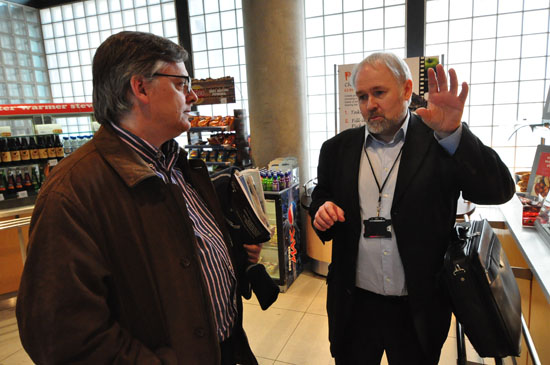 Ramon
Lamarca and Bill Lawrence Ramon
Lamarca and Bill Lawrence Bill Lawrence, now working free lance (from his own company Reel Solutions) was asked by the museum to do the 2011 Widescreen Weekend, and he asked me in November 2010 to come along to co-program the weekend. A weekend which some some people refer to as "my baby". Maybe true, as the WSW truly has a big place in my heart. We began a rather hectic few weeks to plan what to show. Usually we start this in August - a full 6 months before the weekend - but not this year. For various reasons, we didn't have much time to come up with a proposal. It is becoming a challenge to arrange a weekend like this, without repeating titles. It has always been my ambition to find NEW films, so the audience will not feel "Oh, I've seen that before", and stay away. "How the West Was Won" is perhaps the exception, as the audience actually sponsored the preservation of the original magnetic soundtrack years ago, so we have to show that one nearly every year, for sure. |
Reel Solutions |
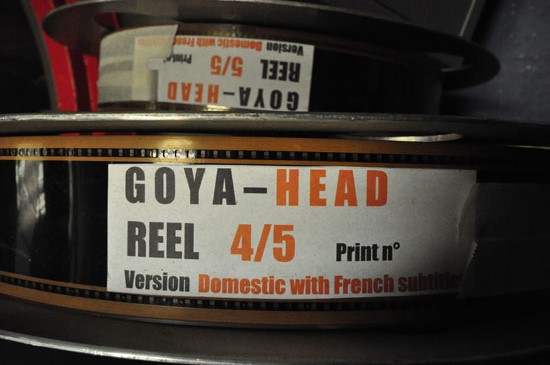 Early drafts included a screening of the 6-8 hour Academy Award winner
"War and Peace", but that idea fell through, only to be replaced with
another Best Foreign Language winner, "Dersu Uzala", which we
had never
shown before. I'm very proud to have been able to include "Dersu", in Sovscope 70
, and also "Goya", the DEFA 70 film from DDR. The latter
had apparently
never been shown in England. Both of which were nice 70mm prints - IN COLOR. Early drafts included a screening of the 6-8 hour Academy Award winner
"War and Peace", but that idea fell through, only to be replaced with
another Best Foreign Language winner, "Dersu Uzala", which we
had never
shown before. I'm very proud to have been able to include "Dersu", in Sovscope 70
, and also "Goya", the DEFA 70 film from DDR. The latter
had apparently
never been shown in England. Both of which were nice 70mm prints - IN COLOR.Another ambition of mine had been to cut the somewhat informal event known as "Cineramacana" entirely, in order to revitalise it. I felt the essence had been watered down the past years with too much video material and 35mm, which didn't really have anything to do with the original idea. Cineramacana had been "born" when we discovered some people could bring odd reels of 70mm to be shown during the weekends in 1996 and 97. Bill invented the word "Cineramacana" to describe this, and since then our ambition grew, and we included A LOT of interesting material and often overshot the schedule - sometimes by a whole hour. I'm to blame for that too, and now I felt the time was right to do something about it. |
|
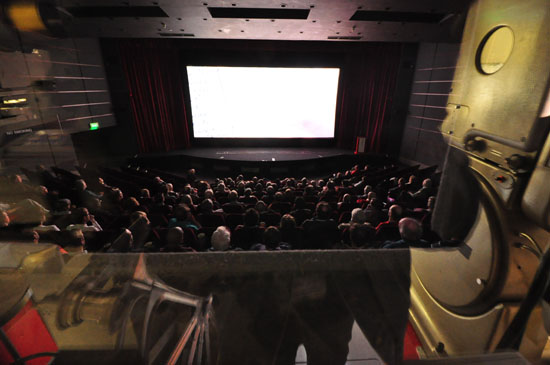 70mm
projection romance view of DP70, screen and the widescreeners reflected
in projection room window 70mm
projection romance view of DP70, screen and the widescreeners reflected
in projection room windowThe compromise became cutting it in two, show the first half on the flat screen Saturday morning, and another "curved" part Sunday morning. I still like to see a "clean" show of odd 70mm reels, something unique, lost for years, and now shown at the Widescreen Weekend. Personally I feel 3D demos have nothing to do with Widescreen Weekend - nice thoughts but not appropriate in this context. |
|
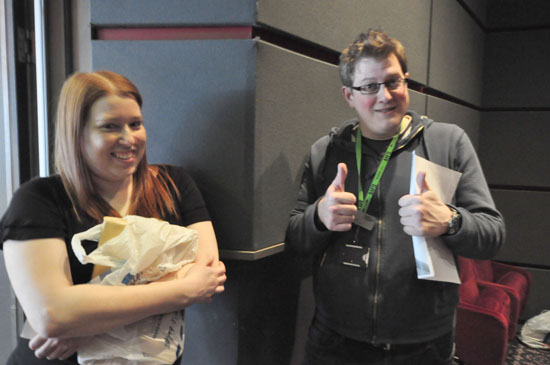 Museum's
Jennifer Hall and Ben Eagle Museum's
Jennifer Hall and Ben EagleAfter "Dersu Uzala", another rare title which had been discussed for more than 10 years was the fabled 70mm print of "Dance Craze". Tony Sloman, well known Widescreen Weekend guest, had talked about this film for many years, and thanks to the legendary Joe Dunton, who actually made the film, "Dance Craze" was brought to Bradford and could be shown again for the first time anywhere in 30 years. Another tick on my to-do list of rare and odd 70mm films to show in Pictureville. |
|
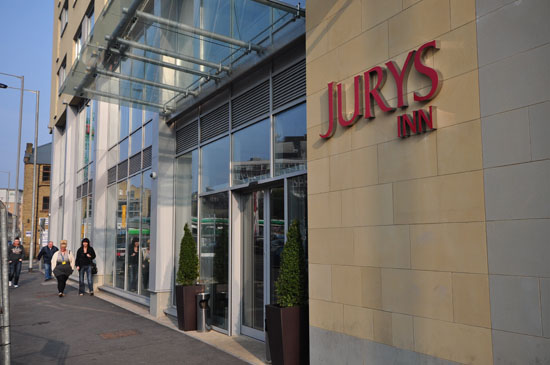 New to the Widescreeners
this year was the new "official" hotel, Jury's Inn, located opposite the
derelict Odeon cinema. A new building and a
modern hotel with free wireless
access. The rooms were fine, but as Wolfram pointed out, there were no
bathroom 230V plugs for a shaver, which seems odd. Nice, spacey and clean
rooms otherwise, but the air-condition in the foyer/bar/restaurant was
objectionable. Simply too cold, and despite asking the staff to adjust it,
nothing happened two days in a row. Other guests also complained about some
excessive party noise Friday night. And since the widescreeners
traditionally lack sleep, this is a problem for many. I don't know what
happened with that in the end, as I didn't notice it myself. The breakfast buffet
served both full English, which I enjoyed for a few days, and traditionally
healthy food too, in the form of yogurt, cereals and fruits. The hotel bar
also featured international beers and English beers, so I decided to indulge with Stella
Artois exclusively this weekend. All in all, a fine new hotel, but it lacks the
ambiance the older Midland has, but what can you expect with a new hotel? My
major complaint was the air-conditioning that required outdoor wear when eating
in their restaurant. New to the Widescreeners
this year was the new "official" hotel, Jury's Inn, located opposite the
derelict Odeon cinema. A new building and a
modern hotel with free wireless
access. The rooms were fine, but as Wolfram pointed out, there were no
bathroom 230V plugs for a shaver, which seems odd. Nice, spacey and clean
rooms otherwise, but the air-condition in the foyer/bar/restaurant was
objectionable. Simply too cold, and despite asking the staff to adjust it,
nothing happened two days in a row. Other guests also complained about some
excessive party noise Friday night. And since the widescreeners
traditionally lack sleep, this is a problem for many. I don't know what
happened with that in the end, as I didn't notice it myself. The breakfast buffet
served both full English, which I enjoyed for a few days, and traditionally
healthy food too, in the form of yogurt, cereals and fruits. The hotel bar
also featured international beers and English beers, so I decided to indulge with Stella
Artois exclusively this weekend. All in all, a fine new hotel, but it lacks the
ambiance the older Midland has, but what can you expect with a new hotel? My
major complaint was the air-conditioning that required outdoor wear when eating
in their restaurant. |
|
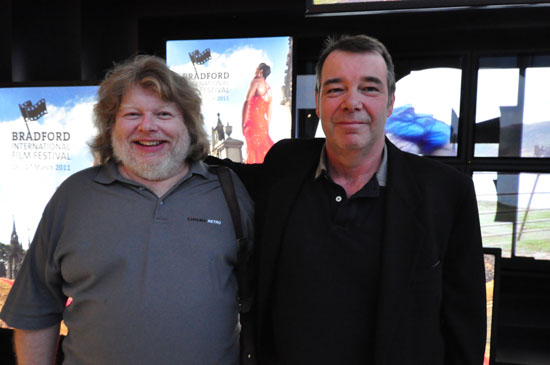 Dave
Worral and Lee Pfeiffer from Cinema Retro Dave
Worral and Lee Pfeiffer from Cinema RetroWhile we're nitpicking here, a couple of additional complaints I heard from several widescreeners during he weekend: Please open the Pictureville bar in the morning, before the first performance starts. Currently, the bar doesn't open until 17:00 which is silly, considering 100-150 people are standing ready, literally to THROW their money in exchange for food, coffee, tea and beers. There is a huge potential for the bar to take care of a very loyal group of audience. A fairly small change, which would make a lot of difference for the audience. |
|
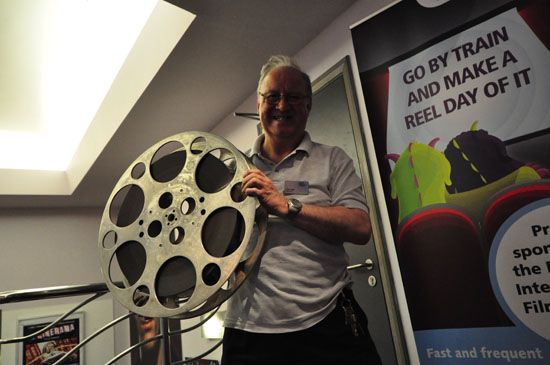 Vintage
projectionist, Tony Cutts, still going strong Vintage
projectionist, Tony Cutts, still going strongI also encountered occasional other comments from attendees who have attended events in Bradford, but who also have experienced some other 70mm screenings at other places in Europe, such as those in Krnov (Czech Republic), Oslo (Norway), and Berlin and Karlsruhe (Germany). There was a subcurrent of concern about the intros sometimes running too long, as well as grumbles about -- the perennial problem -- too little time between events! (....and I must take some of that blame on my own shoulders). I do believe that the effort to split up "Cineramacana" was a success, but even so, even that one tended to run overtime. Based on one event running over, we know it's a tough job to keep entire days running smoothly. |
|
 The
roller screen was repaired by Saturday morning The
roller screen was repaired by Saturday morningWhen we arrived Friday morning in Pictureville, the projectionists discovered there was a serious problem with the flat roller screen. It would not go up - it was stuck. After nearly 20 years of service, the screen decided to go on strike the night before the Widescreen Weekend was to begin. It wasn't too critical on the Friday, since all films were going on the flat screen anyway. More seriously was the Cinerama screening Saturday afternoon. Glad to say the screen was repaired Saturday morning by a company from Essex. They drove 200 miles up starting at 4 in the morning to start work at 8. They managed to fix it and it worked beautifully throughout the rest of the weekend. |
|
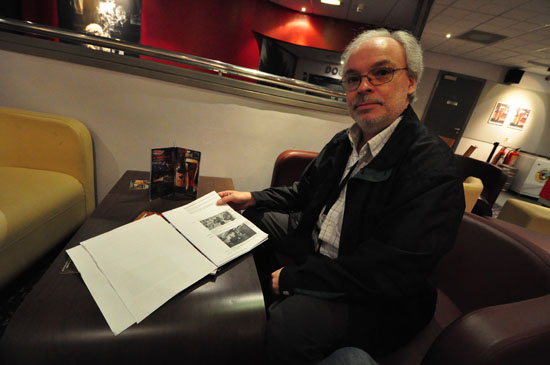 Peter
Andren from Sweden with a complete update on DP70s for in70mm.com Peter
Andren from Sweden with a complete update on DP70s for in70mm.comBill opened the 2011 festival by wishing everyone welcome and announcing the weekend was dedicated to the memory of Howard Rust, who supported Cinerama screenings at the museum until he died just this year, on February 17, 2011. An enthusiastic "widescreener", who will ne missed. The first film was "Goya", and between 60 and 70 guests - the "widescreeners" - were ready for their first dose of 70mm. They had arrived by planes, train and automobiles from England, Germany, Denmark, Sweden, France, Holland and the United States. Wolfram Hannemann - dressed properly for the occasion in his 70mm T-shirt - introduced the film. He is excellent in doing so and it is amazing what he can "dig out" for production information. The audience applauded him, and soon the film started. |
|
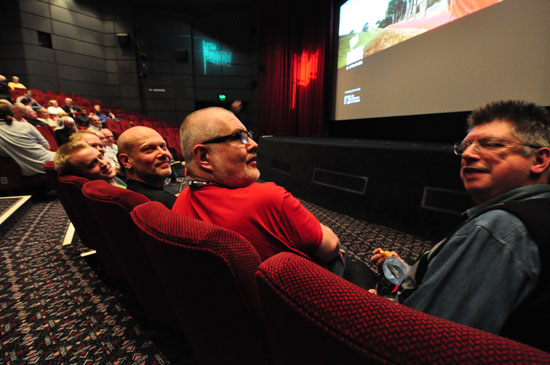 The
Swedish delegation on the front row - they want to be as close as
possible to the movies of course - good guys! The
Swedish delegation on the front row - they want to be as close as
possible to the movies of course - good guys!Before the start of the show, I delivered the projectionist crew a small roll of 70mm film to be prepared for Sunday morning's Cineramacana on the curve. Then I settled in to my seat (G21) to enjoy this classic movie for the first time. I missed it when they ran it 2 years ago during the Berlinale. Being a former projectionist, I enjoy watching the changeover marks, and "Goya" in DEFA 70 was no exception. Gives me a good sense of time, when the reel change happens every 15-20 minutes. The print came from the long-closed Kinopanorama cinema in Paris and had French subtitles. Dialogue was German - being a German film - with some Spanish dialouge included. The color was fine, but maybe lacked some green nuances. The cinematography was really great, and it also had great costumes. A positive surprise. In his intro, Wolfram mentioned the director shortened the film after the release, but he left in "End part One" and "Part Two Start" in the film, indicating a new chapter in Goya's story. In one scene the microphone was very clearly seen for several seconds - great fun, and for me it didn't ruin the overall experience of seeing a rare film such as "Goya" on the big "flat" screen at all. The "usual suspects" in the audience also seemed to enjoy it as they gave it huge applause when it was over. |
|
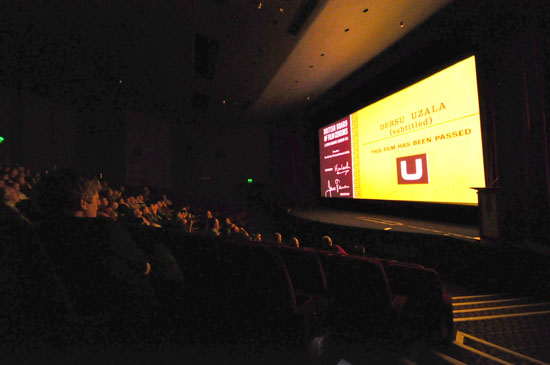 "Dersu
Uzala" censor card, with signatures and everything. "Dersu
Uzala" censor card, with signatures and everything.Next in line was Jasper Sharp's introduction to Kurosawa's masterpiece the great "Dersu Uzala" in Sovscope 70. This time I didn't see the film, as I had seen it recently in Karlsruhe in Germany. There aren't many 70mm prints left and originally I had arranged to show the Danish print which had been shown in Karlsruhe. But at the last moment, a British collector showed up with the original English subtitled print of "Dersu". In Karlsruhe, "Dersu Uzala" with its fantastic story of two men's relationship in Siberia, turned out the be the darling of the festival, and Herbert Born had to show it 4-5 times following the Todd-AO Festival. Before the evenings' Q/A with Claire Bloom in the Pictureville cinema, the traditional delegates reception was held in the Museum's Kodak gallery in the basement. A great opportunity to mingle and connect with the festival guests, share memories and meet new friends of 70mm and Cinerama. This year was no different and even included Mark Lyndon and Sebastian Rosacker dressing up as several key-characters of the festival films. A lot of fun to watch them wear funny hats, reciting memorable lines from the films, including Mark's "Visit Soviet Union before Soviet Union visits you" gag. |
|
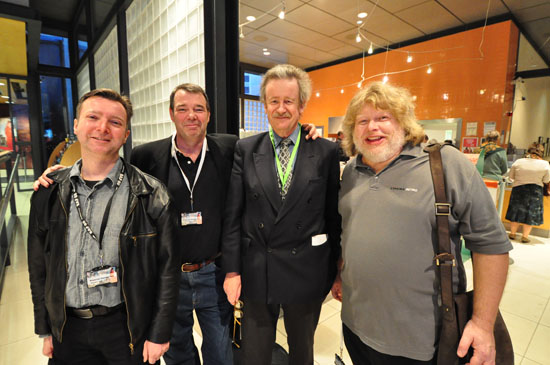 Sheldon
Hall, Lee Pfeiffer, Sir Christopher Frayling and Dave Worral. Sheldon
Hall, Lee Pfeiffer, Sir Christopher Frayling and Dave Worral.Final film of the Friday was a presentation of "The Bridge on the River Kwai" presented by "The David Lean Foundation", a key festival sponsor, and co-introduced by Sir Christopher Frayling and Anthony Reeves. It's a lovely film which I looked forward to see again, not least because it was a new digital version of the film. To me it looked great, fantastic colors and great full width scope (2,55:1). Yes, Sir David knew how to put a film together. Unfortunately for me, I had had two glasses of red wine during the reception and was becoming too tired to watch it and actually fell asleep rather quickly. I'm not a night owl, and really prefer to watch films at 6 in the morning if possible. Hopefully I will get another opportunity another time on a decent sized screen. When Jack Hawkins shot himself in the foot I woke up, and got out Pictureville and went back to the hotel. The fresh air and short walk woke me up enough to add some images to the web site before going to bed for real. |
|
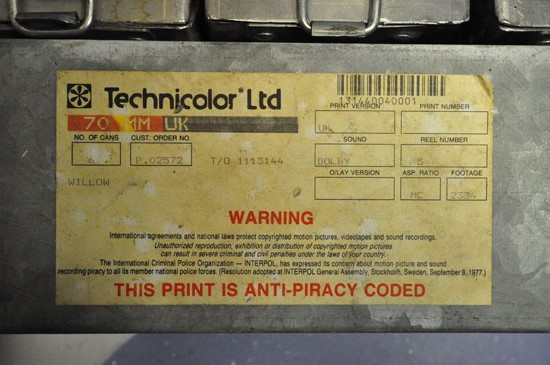 "Willow"
70mm reel with Technicolor's label "Willow"
70mm reel with Technicolor's labelSaturday morning's Cineramacana #1 on the flat screen included a few interesting clips in 70mm: "Tora, Tora, Tora", faded but absolutely interesting to see, and maybe a prospect to show in 2012. Another 70mm clip from "Willow" and a short 35mm Technicolor (Cinestage) sequence from "Around the World in 80 Days" filmed in Todd-AO. "80 Days" was filmed twice in 65mm - one version 24 frames/second and another in 30 frames/second. Also relevant later for the same afternoon and Sunday, were trailers for "The Great Race" in 35mm Technicolor and a trailer from "Dance Craze". The latter unfortunately only presented from a video source, but better than nothing. |
|
 Very early on I had already decided the only film
which would be a "must see" on Saturday
was "Dance Craze" in 70mm, and shot on JDC Super 35. "West" I
had already seen a handful of times, and
"Lawrence of Arabia",
despite it being my all time favourite number 1, was not my cup of tea on the
flat screen. Flat screens I can see everywhere, I prefer to see 70mm films
"distorted" on the curved screens. Instead, I spent the day interviewing
Joe Dunton about "Dance Craze" for a future article on in70mm.com,
and also shared time with Stanley Long to prepare for the on-stage interview
on Sunday. Very early on I had already decided the only film
which would be a "must see" on Saturday
was "Dance Craze" in 70mm, and shot on JDC Super 35. "West" I
had already seen a handful of times, and
"Lawrence of Arabia",
despite it being my all time favourite number 1, was not my cup of tea on the
flat screen. Flat screens I can see everywhere, I prefer to see 70mm films
"distorted" on the curved screens. Instead, I spent the day interviewing
Joe Dunton about "Dance Craze" for a future article on in70mm.com,
and also shared time with Stanley Long to prepare for the on-stage interview
on Sunday. |
|
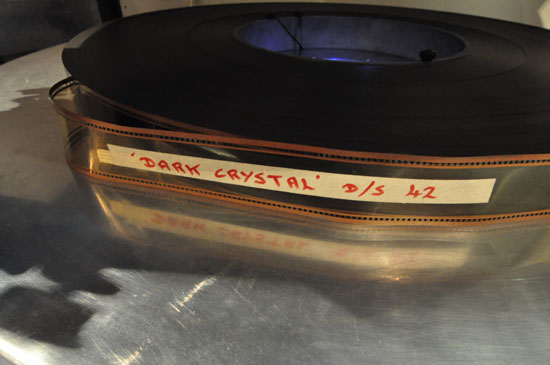 70mm
film on a platter. Whole film splized together, no reel change required 70mm
film on a platter. Whole film splized together, no reel change requiredJoe Dunton arrived when "The Dark Crystal" a children's matinee in 70mm in the flat screen was being run. We managed to find a quiet spot to make a short interview about the genesis and filming of "Dance Craze". I think I recorded about 30 minutes for the interview which is now being typed up as I write this. When the film was released in February 1981 they made 28 35mm prints for Rank's cinemas. Only one 70mm print was made and shown only in London. The film hasn't been shown since. Chrysalis issued a soundtrack and the film is also available as a bootleg DVD, but Joe Dunton is very interested in remastering the film for Blu-ray re-issue. After the UK engagement, an American entrepreneur bought the US rights and Joe sent him nearly all of the 28 35mm prints. The films were a late-night success in US cities, where it alternated with "Rocky Horror Picture Show" every second Saturday. |
|
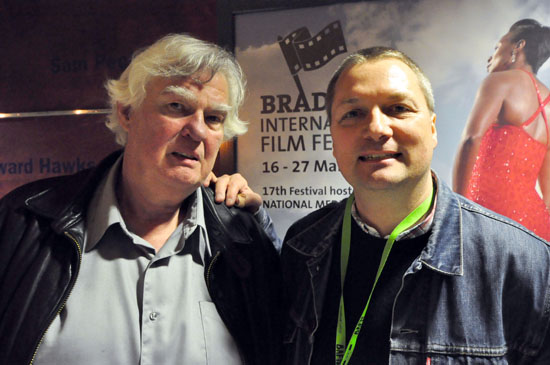 Joe
Dunton and Thomas Hauerslev - both tireless 70mm soldiers, always fighting
for the ultimate in picture quality - 70mm! Joe
Dunton and Thomas Hauerslev - both tireless 70mm soldiers, always fighting
for the ultimate in picture quality - 70mm!Joe Dunton introduced "Dance Craze" on the Saturday afternoon. In short, the film is about a short lived period of British music during the late 1970s and early 1980s called Ska music, or 2-tone. It is essentially a demonstration film to show off a process to get better 70mm prints from 35mm originals. Joe Dunton devised the idea, using the full 35mm academy aperture to get better results when optically enlarging (blow-up) to get 70mm prints. The music was recorded with 24 track recorders using The Rolling Stones music bus and later they re-mixed the 24 tracks down to 6-tracks for 70mm at Abbey Road studios. He named the process Super 35, and it has later become very popular. One of the first commercial users of this process was Hugh Hudson, who filmed "Greystoke, Legend of Tarzan, Lord of the Apes" in 1984. Joe explained they (Technicolor) made 17-18 70mm prints directly from the camera negative - without telling the bank. |
|
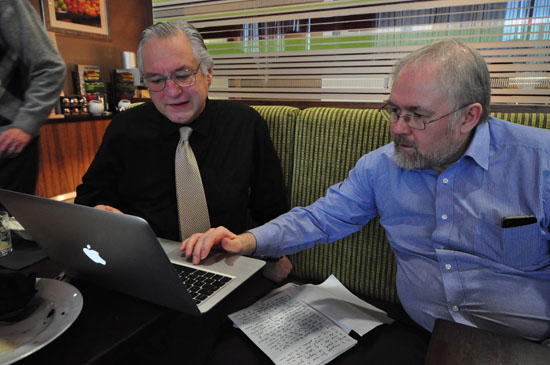 Tony
Sloman and Bill Lawrence makes final adjustments to the speech for Joe
Dunton Tony
Sloman and Bill Lawrence makes final adjustments to the speech for Joe
DuntonI used to be a big fan of the groups Madness and Bad Manners, and I enjoyed seeing them again in "Dance Craze" and not least HEARING them in 70mm 6-track mag in Pictureville. At one point in the film I turned around and addressed Paul Rayton (Chief Projectionist at the Egyptian Theatre in Hollywood) who was sitting right behind me and telling him how good I thought the sound was. A really rich, transparent and full analog mix. He agreed. Lots of bass, very detailed top and singing voices in the midtones - true testament to the quality of magnetic sound. It reminded me a little bit of Verve's CD re-issues of jazz music from the 1960s. I have rarely heard anything like it. It was really good quality sound in a film, which is SOOO missing in todays "wonderful" digital soundtracks, where everything is just LOUD and often sound like they were mixed with small MP3 players in mind (The inferior Blu-ray demo the same morning had been an example of that). Where did all the good film mixers go? After the film, The Academy of the Widescreen Weekend presented it's award to Joe Dunton. Being no stranger to awards, he accepted and we had the official picture taken. |
|
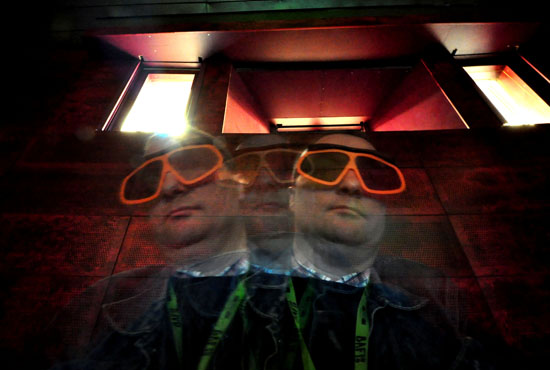 Sometimes
difficult to choose which eye to use during 3D Sometimes
difficult to choose which eye to use during 3DI did see another film on Saturday. Somewhat reluctantly I went to see "Hubble 3D", because I thought at least IMAX would have something good in 3D - they didn't. Yet another trivial IMAX film shot partly in 65mm and also features a lot of blown up video stuff from inside the space shuttle - which even has been 3D-ized for this presentation. The 65mm was EXCELLENT in quality and really shows of just how good large format is. The video scenes were TERRIBLE and really show of how bad video is compared to 65mm. Great! Thanks for demonstrating that. The sound in the IMAX cinema is absolutely spectacular. Completely transparent, fantastic low end BOOM, and incredible dynamic range. It puzzles me why ordinary films never sound this good. All in all, besides some spectacular scenes in IMAX, 3D doesn't add anything to this film, and is only proves the point, that 3D sucks BIG TIME. I look forward to the day when 3D goes away again, and the good images come back. And to the producers: PLEASE work on the IMAX screenplay, rather than making pretty postcards. |
|
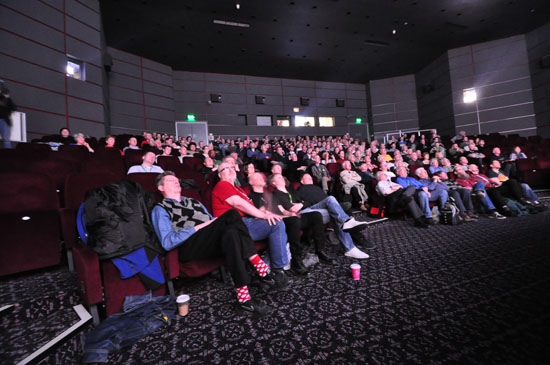 The
widescreeners looking at the Cinerama screen. Note the three beams of
light from Able, Baker and Charlie projection rooms The
widescreeners looking at the Cinerama screen. Note the three beams of
light from Able, Baker and Charlie projection roomsThe most popular film at the Widescreen Weekend continues to be "How the West Was Won". In glorious Technicolor and its original 3-strip Cinerama version. It's a print made at the time of the original release (1962), and has a few minor gaps, especially on the left side, as well as dirt spots. But no matter! It's an antique print - the only one in the world - and we love it, flaws and all. We have shown it year after year and the audience seems to appreciate that, as it is nearly always sold out. This year was no different. Deliberately programmed in the afternoon slot, so people could drive in from afar and return home again on the same day if they should wish to do so. The soundtrack was replaced by a copy some years ago, as the original soundtrack had buckled too much from vinegar syndrome to be played on the Cinerama dubber any more. Thanks to the enthusiasm of the audience, enough money was collected to pay for the copy. |
|
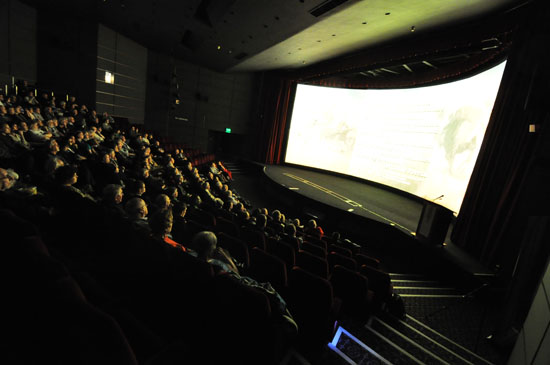 Essential
cinema experience - the audience looking at the curved silver screen,
which actually is made op of luvered strips Essential
cinema experience - the audience looking at the curved silver screen,
which actually is made op of luvered stripsThe 7-track mix of "West" is impressive from the moment the film starts to the very end. This year, ultra short segments had been re-inserted into the print as an extra "attraction". Cut by censors many years ago, the audience could now see someone being axed in the back I understand - what a thrill! The show was introduced by western film-expert extraordinaire Sir Christopher Frayling, who delivered perhaps the longest introduction in Widescreen Weekend history. Our own Tony Sloman may have outdone him years ago, but that was long ago and I cannot cannot be sure. The introduction - a complete lecture in itself - was delivered masterfully and with style and grace to the expert-minded audience, who often knows more about THIS film than any introducer does. A real challenge! Sir Christopher and his wife Helen Frayling then found their seats and saw the film on the huge curved louvered screen appreciated by so many. |
|
 Stan
- the man. Image by Mark Davis Stan
- the man. Image by Mark DavisDuring "West" I met with Stanley Long, who had driven all the way from London to Bradford to be with us to celebrate Circlorama. Stanley suffered a stroke 3 years ago and was a little bit disabled from that, but as he put it "My long term memory was not damaged by the stroke", and indeed so. I first "met" Stanley in 2006, when he wrote me an e-mail to correct a few errors on my in70mm.com page about Circlorama. I managed to talk him into writing the full and correct story of Circlorama, which he did, and more too, as he also supplied some rare photographs to illustrate the story. And now we met again 5 years later - and this time not a virtual meeting. Film Festival photographer Mark Davis took a lot of pictures of the both of us next to the "light box" in the foyer. At one point Stanley illustrated Circlorama with his hands. By pressing this index fingers and thumbs together to form a circle. I grabbed the idea and both of us sat there forming our new widescreeen "hand sign". Bill joined us, and the trio of us had our picture taken like this. |
|
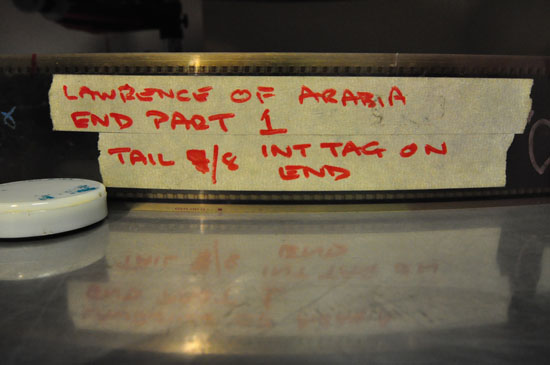 Before I left the cinema to have dinner with Stanley and reminisce about Circlorama, I enjoyed listening to some of Wolfram's
introduction for
"Lawrence of Arabia", to be presented in Super Panavision 70. "Lawrence" was a
near-complete sell-out and I appreciated the "sea" of people sitting
in Pictureville waiting patiently for the film to begin. At the hotel bar I
met with Stanley, Mark and Margaret. While waiting for Bill to join us, we
had a few beers in the bar/foyer, but it was so cold, that the beer felt
nice and warm. This is a joke of course, but it WAS too cold, no thanks to
over-achieving aircondition system. Sebastian from Sweden later joined us
there. Before I left the cinema to have dinner with Stanley and reminisce about Circlorama, I enjoyed listening to some of Wolfram's
introduction for
"Lawrence of Arabia", to be presented in Super Panavision 70. "Lawrence" was a
near-complete sell-out and I appreciated the "sea" of people sitting
in Pictureville waiting patiently for the film to begin. At the hotel bar I
met with Stanley, Mark and Margaret. While waiting for Bill to join us, we
had a few beers in the bar/foyer, but it was so cold, that the beer felt
nice and warm. This is a joke of course, but it WAS too cold, no thanks to
over-achieving aircondition system. Sebastian from Sweden later joined us
there.Before going to bed, I added yet another set of pictures to the web site, so people NOT attending, had a chance to see what they were missing. |
|
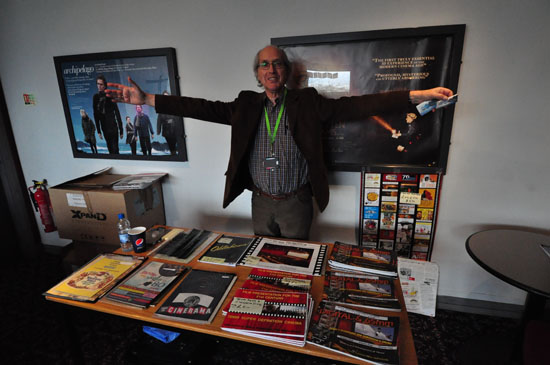 Johan
Wolthuis, Holland, A very loyal 70mm soldier, selling his books Johan
Wolthuis, Holland, A very loyal 70mm soldier, selling his booksJohan Wolthuis from Holland, original founder of The International 70mm Association in 1988, and the first editor of The 70mm Newsletter, was there to sell his latest book about the 70mm films we all love. Johan sold 14 books and 6 posters - please support Johan. He made 2000 copies, and sold less than 200 so far. |
70mmpublishers.nl |
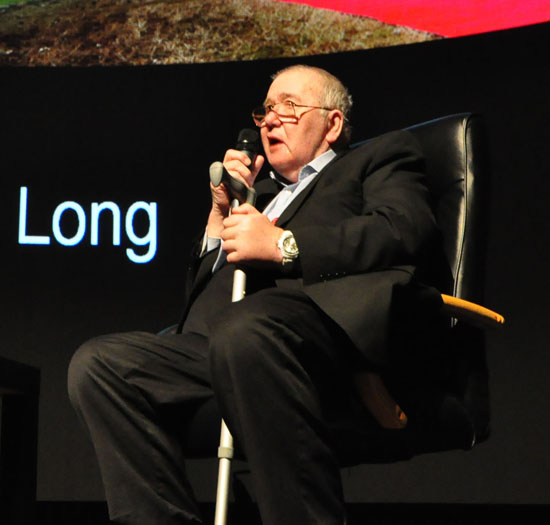 Stanley
Long on stage talking about Circlorama. Stanley
Long on stage talking about Circlorama. Cineramacana #2 Sunday morning was on the magnificent Cinerama curve. Among the clips shown this morning was a short 6-track channel audio test reel recorded on "Scent of Mystery" footage, two musical numbers in (official festival color) faded and SHARP Todd-AO from "South Pacific" and "Hello, Dolly!". Both of which were prepared by Tony Cutts, retired and skilled DP70 aficionado, brought in to help out during the Widescreen Weekend. The three clips were concluded by the animated "Roller Coaster Rabbit" lots of fun in 70mm and on the giant curved screen. And also, another perennial 3-strip favorite, the genuine Cinerama 3-strip advertisement for Renault "Dauphine" automobiles. |
|
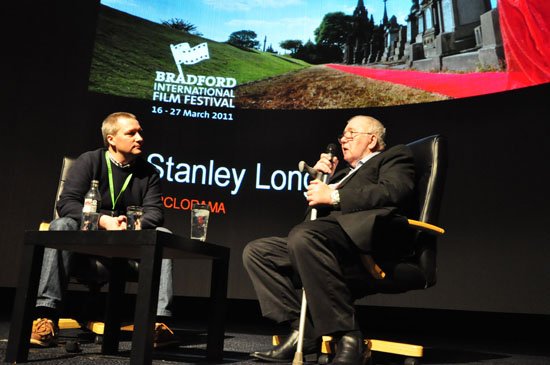 Stanley
Long on stage talking about Circlorama. Stanley
Long on stage talking about Circlorama.I had the privilege to present Stanley Long to the audience Sunday morning for a talk about him and the story of Circlorama. Stanley reflected, and told the audience: "Who'd have thought 50 years ago, I would be sitting here talking about Circlorama?". Stanley entertained the audience and had a good sense of timing, which made the audience roar with laughter. My job was easy, Stanley had no problem talking for 30 minutes straight, with myself only supporting him occasionally, leading him in a direction. We finished the talk by asking how many of the audience who had actually seen the original Circlorama. An amazing 17 people in the audience remembered the process well. I finished the interview by asking the floor if there were any questions - and as expected many had good questions for Stanley. |
|
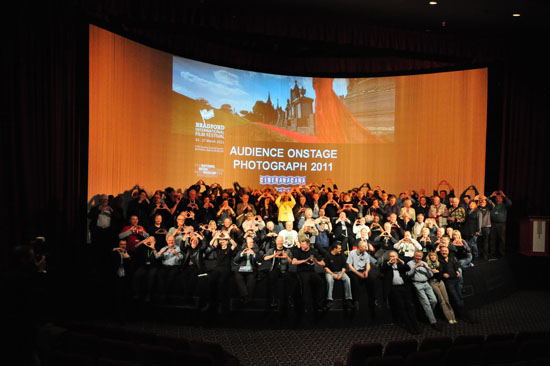 Widescreeners
on stage. Stanley Long is sitting proudly in the middle. Widescreeners
on stage. Stanley Long is sitting proudly in the middle. Before finishing Cineramacana #2, it was time to take the annual "Class picture", aka. "Audience on Stage". Starting in 1996 with 20 people or less, outside the Pictureville cinema, the picture idea was later adopted by Bill, moved inside, probably because of rain, on to the stage, in front of the curved screen. Year on year, the number of people taking part in this is has gone up to more than 100. The task of taking the picture is split into two jobs. Paul Rayton has fallen into the responsibility to "wrangle" all the good folks on the stage, getting them to look line up smoothly and at the camera, and myself setting up the camera and making the test shots. In the past, I've set the timer, pushed the button, run down the stairs and jumped on the stage, hopefully before the shutter clicks, much to the entertainment of the audience. This year I felt as a genuine DP, as I was privileged in having my own assistant to "push the button", in the form of NMM's Mark Davis. I didn't have to run, and didn't risk breaking a leg on the stairs. Now I got on stage in an orderly fashion. An additional picture was also taken to document the new "Circlorama handsign". I asked the people on stage to make the sign, while I took the picture. Great fun with Stanley Long sitting proudly in the middle. Both images are available for free download. Stanley then continued in the foyer signing books and DVDs. |
|
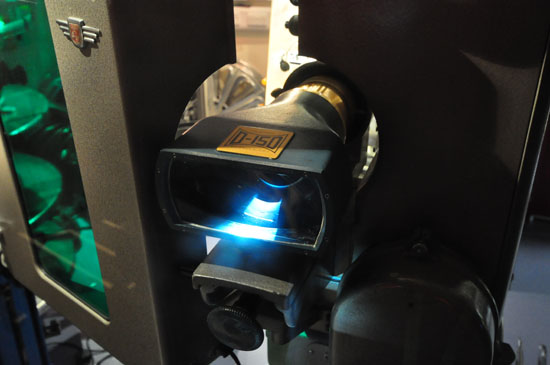 The
DP70 projector from Denmark, and the Dimension 150 lens from Richard
Vetter, USA The
DP70 projector from Denmark, and the Dimension 150 lens from Richard
Vetter, USAOne of the films I had been looking forward to see was the digital version of "Doctor Zhivago" on the flat screen, which turned out to be a mixed bag. Wolfram gave it a fine introduction, including the fact that Ingrid Pitt ["Where Eagles Dare"] was in the film, and could be seen 5 different places in 5 different roles. I think I saw her as a bystander when Komarowski is being shot by Lara. I'll have to re-check the Blu-ray soon. Apparently the "Doctor" looked very good, but in some scenes the digital origin was visible - personally I don't know what it is, but it looks like some shimmering of straight lines, a pattern of some sort. |
|
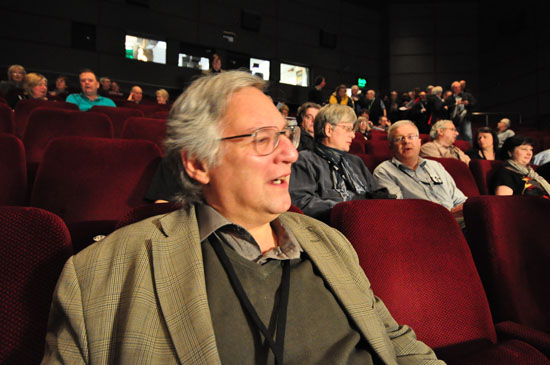 Tony
Sloman, passionate about film. Tony
Sloman, passionate about film.It's not any worse than scratches or dust are in a 35mm/70mm print, but as it is digital, it must be "perfect". The soundtrack was really strange, as there were no ambience or effects sounds. It was all dialogue (directional, so that was fine), music, and overall very flat and unimpressive. The screening left me rather disappointed with this version. Tony Sloman, who hates digital, was furious, blamed Park Circus and I had to calm him down in the foyer "It's just a movie, relax". He felt it was a Dolby mix, and thereby amputated all the original effects. Technically speaking, d-cinema audio playback is full range, uncompressed "wave" files, so any quibbles now must go to the creators of the restoration. I thought digital was not Dolby at all, anyway, so I hope someone might re-make the soundtrack, for this was not good enough for Sir David's film. I'm glad we showed "Zhivago" in digital with color, however, as the previous Monday morning give-away a few years ago (2006) was a catastrophe, as that 70mm print was completely faded. |
|
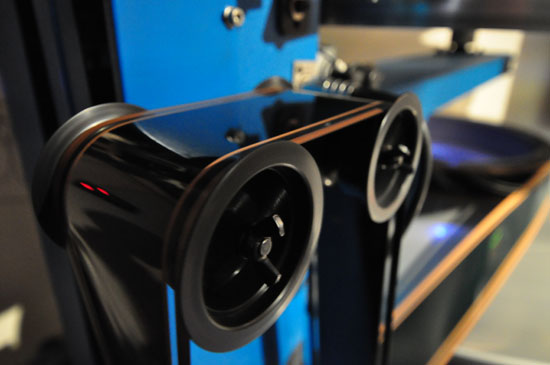 The last film of the day, was "The Lion in Winter" in 70mm on the
flat screen. I had already seen it in
2004 on the curve, and didn't feel
like watching it again, so I went back to the hotel with Mark and Margaret
to rest 3 hours until 8 o'clock, when we planned to go to nearby Indian
restaurant Omar Khans for a
curry. John Barry's music is lovely, but the action is too much over the top
- like Laurence Olivier on steroids with a touch of irony. I later heard
there were several walk-outs. The last film of the day, was "The Lion in Winter" in 70mm on the
flat screen. I had already seen it in
2004 on the curve, and didn't feel
like watching it again, so I went back to the hotel with Mark and Margaret
to rest 3 hours until 8 o'clock, when we planned to go to nearby Indian
restaurant Omar Khans for a
curry. John Barry's music is lovely, but the action is too much over the top
- like Laurence Olivier on steroids with a touch of irony. I later heard
there were several walk-outs. |
|
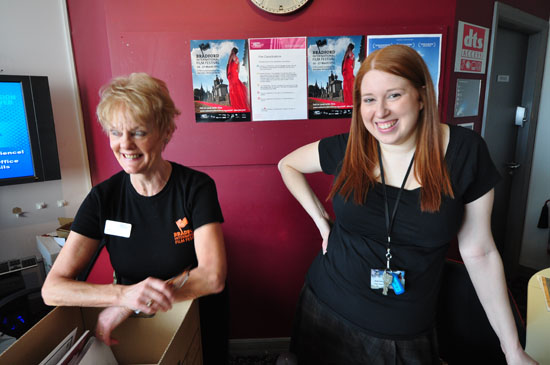 Museum's Joan
and Jennifer. Museum's Joan
and Jennifer. Monday morning's two films, nicknamed the "Double Bill" by myself a few years ago in honor of Bill's achievements - being the Godfather of the Widescreen Weekend since the beginning - was in fact a triple bill this year. The second feature on this spring morning menu "The Great Race", would be preceded by a short, "Push Button Go" (aka "Shellarama") presented on the curve in Super Technirama 70. The weekend was coming to an end as Bill said good morning to a large number of widescreeners including myself, who all decided to enjoy the opening event, a curved screen blow up 70mm 6-track stereo presentation of "Operation Crossbow" with directional dialouge. Tony Sloman introduced the film with lengthy anecdotes about the production of the film. It has been many years since I'd seen it, and almost forgotten it. After that, a final intermission, and then the short followed by "The Great Race", the classic comedy by the late Blake Edwards. Sheldon Hall had the honor to give the last introduction of 2011's Widescreen Weekend. I had to leave mid-performance to catch the train for Manchester Airport and my plane for Copenhagen. Anders Olsson from Lund in Sweden and myself had our final pint of beer in the airport, reminiscing about the weekend. |
|
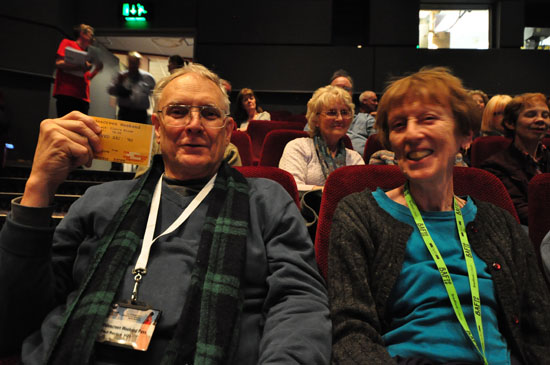 Peggy
& Paul Rayton, USA Peggy
& Paul Rayton, USAAs I end this, I'd like to thank the whole Pictureville crew for a weekend well done. Both in the back office, box office and projection department. I was pleased to be back, meeting our "70mm family" of friends and widescreeners. Besides seeing 70mm film on the curved screen, it also thrills me to see the old DP70 Todd-AO 70mm projector, still doing an outstanding job. Donated more than 10 years ago by Nordisk Film here in Copenhagen, and equipped with the D-150 lens, personally supplied to Pictureville by Dr. Dick Vetter, together projecting rock steady and very sharp 70mm pictures. Images which continue to attract the best audience in the world - the widescreeners of The Widescreen Weekend. Read what the audience think: "It's Bloody Marvellous" Widescreen Weekend 2011 |
|
| Go: back - top - back issues - news index Updated 22-01-25 |
